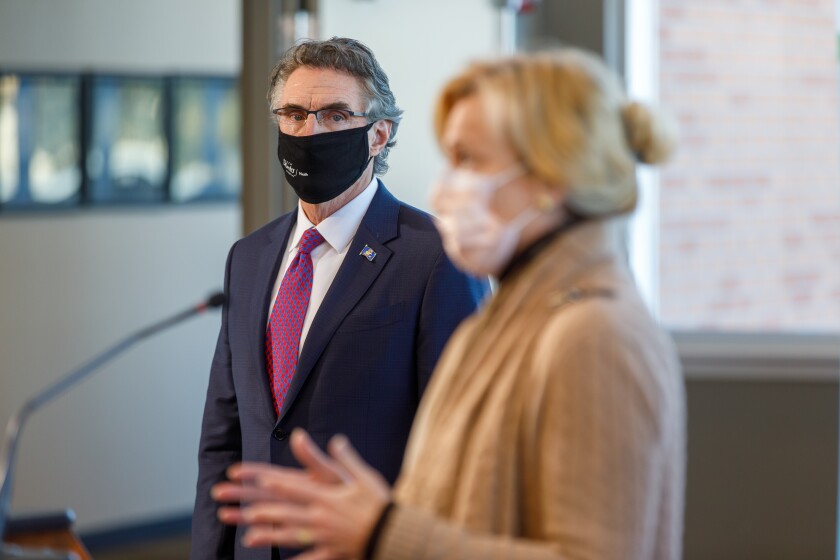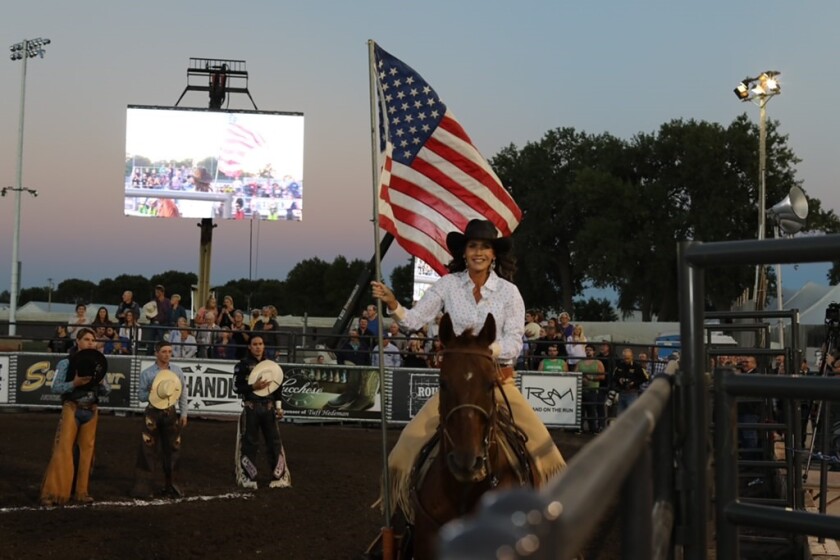BISMARCK — With COVID-19 cases running out of control in North Dakota in mid-November, Gov. Doug Burgum intervened, installing a statewide mask mandate. A month and a half later, the state's pandemic status is nearly unrecognizable: Active virus cases have descended from more than 10,000 at the time of the mandate to fewer than 2,000 today.
But neighboring South Dakota, which had vied with North Dakota for the worst-in-the-nation per capita metrics for much of October and November, has experienced a similarly remarkable turnaround, and without any significant state-level intervention.
With both Dakotas on the mend after taking divergent policy approaches at their worst moments of the fall surge, South Dakota's COVID-19 curve has become the subject of regional debate, emerging as a kind of Rorschach test for the effectiveness of mask mandates: Opponents of mandates have pointed to South Dakota's decline as proof that the North Dakota policy was an unnecessary overreach, while advocates cite differing rates of decline between the two states as evidence of the opposite.
"Rather than following the pack and mandating harsh rules, South Dakota provides our residents with information about what is happening on the ground in our state — the science, facts and data," said South Dakota Gov. Kristi Noem in her legislative budget address in early December, heralding her state’s commitment to its laissez-faire pandemic response and going on to trumpet its newly downward trends.
Right-wing conservatives across the state line have also held up South Dakota as a smoking gun in their arguments against government action. Rep. Rick Becker, R-Bismarck, who has been one of the most visible opponents of government intervention in North Dakota, argued that the downward trend in South Dakota validates his long-held position. "Thank goodness South Dakota didn't institute a mask mandate,” he said. “Otherwise it'd be virtually impossible to prove the point or have the evidence for the argument — which I was making prior to our mask mandate — that our curve was about to go down.”
ADVERTISEMENT
But to Dr. Paul Carson, an infectious disease specialist at North Dakota State University, these kinds of pat answers are the Rorschach test at work. "People want to see into it what they want to see into it,” he said. “But that’s a simplistic way of looking at it. I think the question is more nuanced than that.”
For Carson, the sudden divergence between the Dakotas presents a rare scientific opportunity, “a natural experiment that has played out before our eyes.” He noted that many similarities between North Dakota and South Dakota — including similar population sizes, ethnic makeups and urban-rural mixes, as well as a pair of Republican governors both averse to direct intervention for much of the pandemic — lend the states to obvious comparison. In fact, the Dakotas' mask mandate split has become such a topic of interest in the academic sphere, Carson said, that he’s already assembling a research team to formally study it for himself.
While Carson emphasized that low virus testing in South Dakota leaves observers with an incomplete picture of its outbreak, he also said that a few different metrics suggest that North Dakota is recovering from its virus surge faster than South Dakota, a trend he attributed to Burgum's statewide mandate.
Hospitalizations, Carson noted, offer a more objective measure that gets around the testing disparity. South Dakota hit a higher hospitalization climax than North Dakota, both in its seven-day rolling average and adjusted per capita figures, and has fallen "much slower" than North Dakota since then. North Dakota's seven-day average hospitalization numbers crested at 406 cases per day on Nov. 16, earlier than South Dakota's peak of 581 hospitalizations per day on Nov. 23. The “kicker,” Carson noted, is in their margins of decline since then. By Dec. 19, North Dakota had fallen more than 50% from its average hospitalizations high. By contrast, South Dakota had dropped just 29% over the same interval and still had not cleared the 50% threshold as of Dec. 30.
Bonny Specker, an epidemiologist at South Dakota State University, similarly pointed to a steeper pace of per capita case decline in North Dakota as evidence of its faster recovery. At the time North Dakota announced its mandate, both Dakotas were hitting their case number highs, she noted, with North Dakota peaking above South Dakota in its reported case numbers. "But the drop in ND cases has been quite a bit more dramatic than what we have seen for SD," wrote Specker, a sign of faster recovery that she also attributed to Burgum's mask mandate.
But even with the many commonalities between the two states, experts warned against drawing firm conclusions at this point. Any parallel must come with the major caveat that South Dakota tests for the virus far less than North Dakota (North Dakota has consistently ranked in the top three states nationally in per capita testing, while South Dakota currently falls in the bottom 10), at levels so starkly different that Grace Njau, an epidemiologist with the North Dakota Department of Health, said it is very hard to do "an apples to apples" comparison between the Dakotas.
Further muddying the waters, Njau countered the narrative, pushed in some anti-mask circles, that South Dakota is a clean example of a state that did nothing to head off its outbreak. Even though Noem eschewed state-level action, masking compliance seems to have climbed steadily in South Dakota this fall , and the state's own patchwork of local mask mandates may have helped to turn the state around, Njau argued.
ADVERTISEMENT
“To me, it does tell me that they are doing something. It just may not be as visible or as pronounced as what North Dakota may be doing,” she said.
Specker similarly pointed to a mask mandate in the city of Brookings, S.D., from back in September as one example of local intervention in her state that may have helped to reverse the statewide trend. Of South Dakota's 10 most populous cities, Brookings has emerged from the fall surge with the fewest cumulative cases per capita, a phenomenon that Specker said can likely be explained in part by its local mandate.

But given the across-the-board similarities between North Dakota and South Dakota, Burgum's statewide mask mandate is one of few significantly different variables at play.
"The statewide mandate works very well in complimenting local mandates," Njau said of its North Dakota impact.
"B ehavior may change because of policies, but we don’t know that for sure," noted Carson. Expounding by email, he added, "I have to surmise (North Dakota's) more rapid decline in cases and hospitalizations is being expedited by the policy measures implemented by the Governor."
As Carson watches the pandemic ebb and flow around the country, he said he’s still developing his own theories on how exactly this virus spreads and which tactics are most effective at slowing it down. “Pain and suffering” seem to play a powerful role, he said, and widespread exposure to the virus does seem to have woken up more people to its reality in the Dakotas, helping to shift behavior.
ADVERTISEMENT
The infectious disease professor said he’s been kicking around another theory, too. It may be that the virus strikes in clusters, infecting the groups most inclined to defy precautions first, similar to a fire steadily igniting separate stacks of wood all sitting at varying distances from the central flame.
“You may burn through the most risk-taking susceptible groups early,” he said. This phenomenon does not get a population near true herd immunity, but it could explain why the virus has stopped spreading among nearly as many residents in the Dakotas. “You no longer have tinder to burn.”
These are theories, and no hypothesis is perfect, Carson stressed. But with limited information, he said he favors more precaution than less, especially with vaccines rolling out and a potential end on the horizon. Carson argued that there's no easy explanation for why some states succeed and others flounder, and it's too soon to settle on neat answers to complex questions.
“We will be studying this for the next 10 years,” he said.
Readers can reach Forum reporter Adam Willis, a Report for America corps member, at awillis@forumcomm.com.








